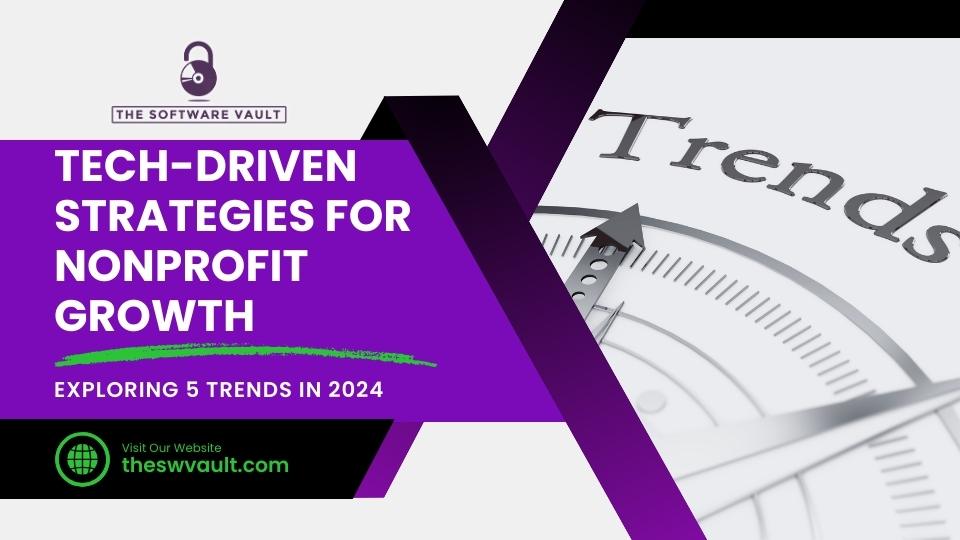Exploring 5 Trends in 2024
In today’s rapidly evolving digital landscape, more and more nonprofit organizations are recognizing the need to embrace digital transformation to effectively increase funding, improve operational productivity, and enhance operational performance with limited resources. As we step into 2024, several emerging trends are shaping the way nonprofits could leverage technology for their mission-driven work. Let’s explore five key trends that nonprofit leaders should pay attention to:
1. AI-Driven Donor Insights
In 2023, Artificial Intelligence (AI) caused quite a stir, evoking a wide range of emotions among people. As AI technology continues to advance, its impact on society and various industries has led to both excitement (yay!) and apprehension (oh!). On one hand, there is enthusiasm about the potential benefits that AI can bring, such as increased efficiency, improved decision-making, and enhanced convenience in daily life. However, there are also concerns about the ethical implications, privacy issues, and potential job displacement that AI may bring.
What if I tell you that AI can revolutionize the way nonprofits understand and engage with their donors. By leveraging AI-powered analytics tools, organizations can gain deep insights into donor behavior, preferences, and motivations. These insights enable nonprofits to personalize their communications, tailor fundraising strategies, and create more meaningful connections with their supporters.
Furthermore, AI can help identify potential major donors and predict giving patterns, leading to more targeted and effective fundraising campaigns. How great is that!
2. Virtual Fundraising Experiences
With the rise of virtual events and digital platforms, it is time to re-imagine those traditional fundraising events. Many nonprofit organizations have utilized Peer-to-Peer Fundraising Campaigns and Online Auctions to reach a wider audience while reducing overhead costs.
But what about Virtual Galas? Interactive technologies, such as Augmented Reality and Live Streaming can be leveraged to create immersive and engaging experiences that drive donations and foster donor engagement. Virtual experiences allows nonprofits to expand their reach beyond geographical limitations and connect with supporters worldwide.
3. Data Ethics and Privacy
As nonprofits increasingly collect and analyze vast amounts of data, it is crucial to prioritize data ethics, data privacy, and data security. Donors and stakeholders are becoming more conscious of how their personal information is being used. As a result, nonprofit organizations must adopt transparent data practices, implement robust security measures, and adhere to regulations like the General Data Protection Regulation (GDPR) and other local data protection laws. Demonstrating responsible handling of donor data builds trust and ensures long-term relationships with supporters.
4. Automation for Productivity Gains
Automation technologies, such as Robotic Process Automation (RPA) and workflow management systems can transform nonprofit operations. By automating time-consuming tasks like data entry, report generation, and administrative processes, to name a few, nonprofits can free up valuable staff resources to focus on more strategic initiatives. This is major! Why? Most nonprofit organizations have limited human resources and automation technologies can help increase capacity when implemented correctly. Automation not only improves productivity and increases capacity, but it also reduces errors, increases efficiency, and enables nonprofits to make data-driven decisions.
5. Collaboration through Digital Platforms
Nonprofits are increasingly collaborating with partners, volunteers, and other organizations to maximize their impact. After all, there is power in partnerships! Digital platforms and cloud-based tools can be used to facilitate seamless collaboration by enabling real-time communication, file sharing, and project management across geographically dispersed teams. Embracing collaborative technologies can help to streamline internal workflows, enhance collaboration with stakeholders, and foster a culture of innovation and agility.
Embracing these emerging trends around digital transformation can help nonprofit organizations stay ahead in the ever-evolving landscape of fundraising, productivity, and performance. By leveraging AI for donor insights, embracing virtual fundraising experiences, prioritizing data ethics, adopting automation for productivity gains, and utilizing digital collaboration platforms, nonprofits can create a strong foundation for success in 2024 and beyond.
Remember, true digital transformation is not just about adopting technology; it is about integrating technology into every aspect of an organization’s strategy, culture, and operations. With careful planning and a commitment to innovation, nonprofits can embark on a transformative journey that drives sustainable growth and enables them to better serve their mission and communities.
If you need assistance in implementing one or more of these strategies or exploring technology solutions, reach out to our team. We’re here to support organizations like yours in achieving operational excellence and cost reductions.
Disclaimer: This blog post is intended for informational purposes only and does not constitute professional advice. Organizations should evaluate their specific needs and consult with technology experts before making any decisions.

